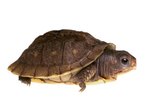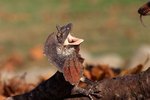When caring for pet tortoises, it's important to find the species that best suits the space and time you can devote to their care. Both the Russian and Hermann's tortoises are small creatures packed with personality that only require a few feet of your home. It won't be hard to fall in love with either species.
Homeland
Native to a wide range throughout warmer areas of Europe, the Hermann's tortoise (Testudo hermanni) thrives on coarse, arid, scrubby hillsides. Russian tortoises (Testudo horsfieldii), also found in the Mediterranean, are actually native to areas such as Afghanistan, Northern Pakistan, Northern and Eastern Iran that are dry and arid, such as sandy or loamy steppes or rocky deserts.
Size, Lifespan, and Temperament
Hermann's tortoises reach about five to 10 inches, similar to Russian tortoises, which average about six to 10 inches. Both species are relatively small with long lifespans -- 75 years or more for Hermann’s, and 50 to 80 years for the Russian tortoise. Both have outgoing personalities; although each individual tortoise is different, much as with people, you will find some may be shy, whereas others may be clowns.
Captive Enclosure
Since both are smaller tortoises, they can be housed in indoor enclosures, but it is ideal to create an outdoor space for natural lighting and weather. With indoor enclosures, you want to use a minimum of a 50-gallon tote, or a Christmas tree storage bin. An enclosure measuring 3 by 4 feet works well outdoors. Russian tortoises can be major burrowers, whereas for Hermann's tortoises, this is less of a problem. Bury a layer of hardware cloth around the perimeter so that the tortoise cannot dig out, especially for a Russian.
Diet
These Mediterranean species have the same basic diet. A spring mix bag of lettuces can provide a good staple diet, but you want to mix in other greens, weeds and grasses, including endive, escarole, radicchio, and chicory. They also eat timothy hay, mulberry leaves, dandelion leaves and flowers, and opuntia cactus. The diet of either the Russian or Hermann's tortoise needs to be high in fiber and calcium but low in protein and fat.




